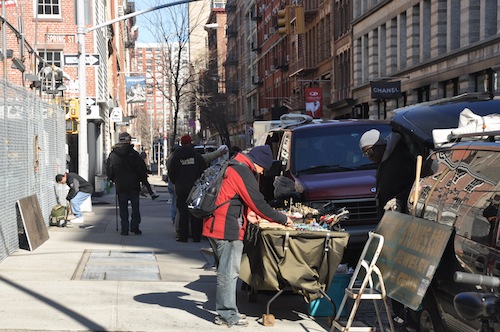Just what SoHo needs, another commercial building with a high-end tenant selling upscale merchandise? Right? Wrong!
According to the New York Post, a new five-story building will rise on the ashes of the beloved SoHo Flea market at Spring and Wooster Streets which was closed down abruptly on February 1st after the owner, an affiliate of Centaur Properties, sold the space. Although everyone knew that the property was for sale, with a big sign from Sinvin Realty hanging on the side of an adjacent building, happily, nothing ever happened. The 20 by 80 foot parcel remained a flea market, subleased to 10 vendors who were willing to pay $2000 monthly for front spaces and $2400 for back spaces. The rent was steep but sales were brisk and none of the vendors could afford renting their own small store, where the going rate of $200 per square foot in that prime location would mean a monthly tab of $16,000.
Years back, plans were actually prepared for a new building but a dip in the NYC economy nixed the deal and the sellers of hats, jewelry, t-shirts, sunglasses, and clothing prevailed, Whatever the season, they offered new and tempting merchandise for sale: Fur-lined hats for winter, baseball caps for summer, Obama T-shirts for the election. Like the mailman, they braved snow, sleet, rain, and the summer sun, to hawk their wares to the tourists, domestic and foreign. And to SoHo natives, too, people like me who could count on the flea market for a little gift that they could not find in Chanel across Wooster Street or in Prada on Broadway. A pair of earrings for $35 of sterling silver made by Hassan Rabah (sterlingstonesnyc.com) who makes his own jewelry of sterling silver and semi-precious stones. Originally from Lebanon, Rabah came to the SoHo flea market in July 2002 after first selling his creations at the Tower Market on West 4th Street and Broadway. Rabah said that he and the other vendors had only two weeks notice that the property was sold and that their manager had lost his lease. "It was unfair to us and to our families," said Rabah who has two young children.
Rabah, and two other flea market vendors, Park and Mary Njaga, have set up tables on the sidewalk now, pairing up with veterans through the New York City Department of Consumer Affairs Vendor Vet Program. Park's partner is Hector Concepcion, who sports his purple heart pin for service as a Navy combat medic in Beirut on his baseball cap. Since the process for applying for a vendor permit is slow and the lists are long, teaming up with the vets made sense for the displaced vendors.
Park, who sells hats, costume jewelry and sunglasses, has set up his new table at the corner of Spring and Wooster Streets. His view on why it was closed down without giving them much warning: "They're rich people," he said. "They don't want to be bothered. What do they care?"
Down the block at Spring and West Broadway, flea market vendor Mary Njaga from Kenya has paired up with vendor vet, Victor Lebron. Njaga, from Kenya has had many careers -- stewardess, saleswoman, and businesswoman, shipping handicrafts from Kenya. For seven years, Njaga sold jewelry and hats at the SoHo flea market where her business was very good. Njaga does not understand why the new owner was in such a hurry to kick them out and erect a chain link fence around the lot.
Meanwhile, on Wooster Street (144 Spring Street), the New York Post reports that Ralph Bartel, the founder of Travelzoo and a major investor in Lanvin and Devi Kroell, is buying the vacant lot to construct a retail building for one of his brands. The price: nearly $30 million. "That's a lot of money," says next-door neighbor Shael Shapiro. "I could have bought the lot in the mid-1970s for $125,000, but didn't think it was worth that much."
Roslyn Bernstein is an arts journalist and professor of journalism at Baruch College and the CUNY Graduate School of Journalism. She is the author of 'Boardwalk Stories' and the co-author, with Shael Shapiro, of 'Illegal Living: 80 Wooster Street and the Evolution of SoHo.'
